
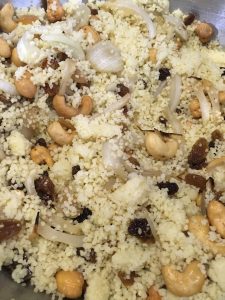

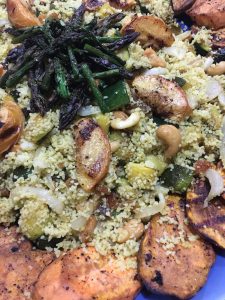
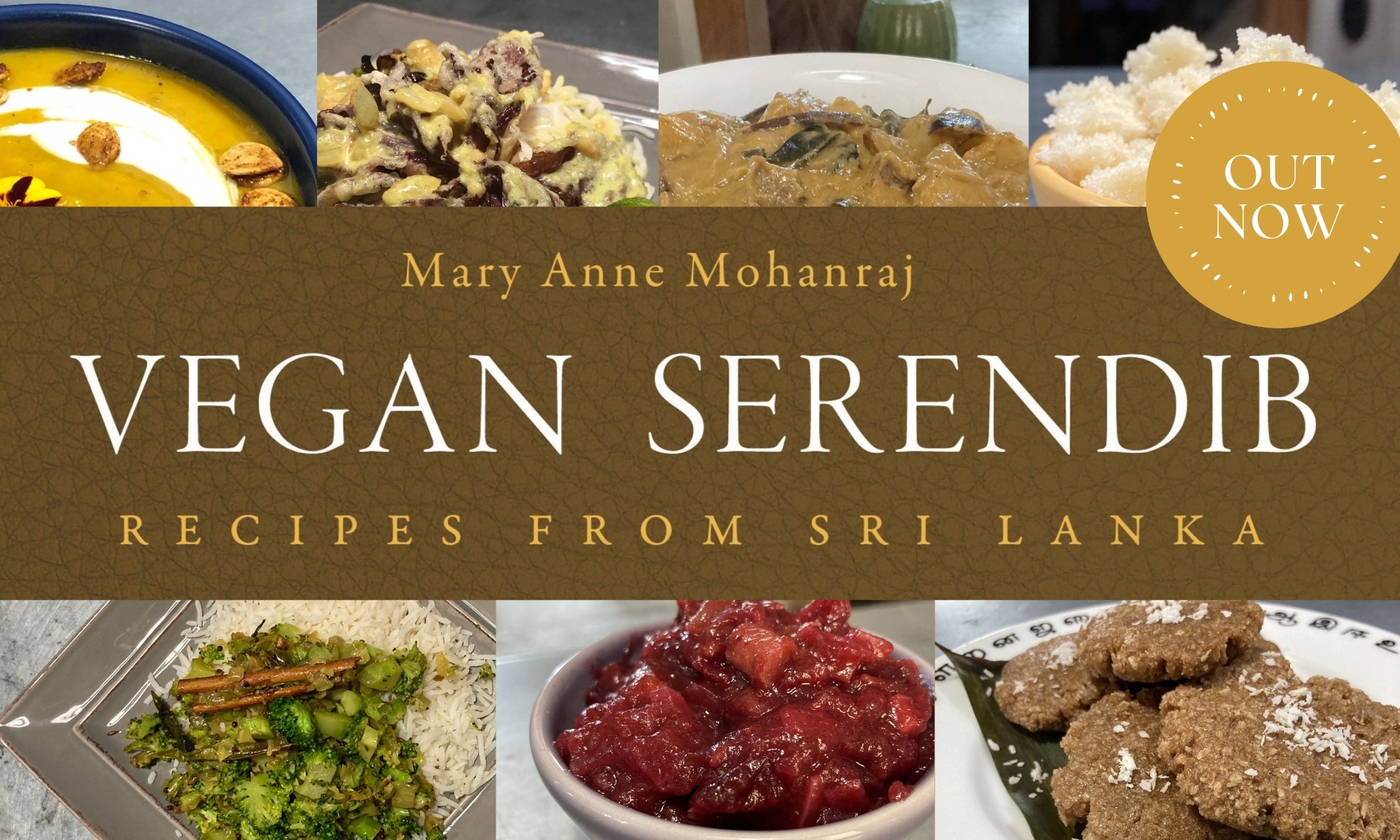
with Mary Anne Mohanraj




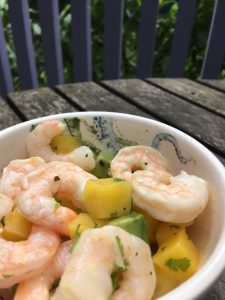 Spicy Shrimp with Avocado and Mango
Spicy Shrimp with Avocado and Mango
(10 minutes, serves 1-2)
I had some frozen cooked shrimp that I’d bought by mistake (usually I prefer to buy raw and cook them, which lets you use them well in a greater variety of preparations), so I was a little stuck trying to decide what to do with them. I wanted spicy, fruity, rich and satisfying enough that I didn’t feel the need for additional bread or rice. This delivered nicely, and was particularly pleasant to eat on the back deck, enjoying a perfect early summer day.
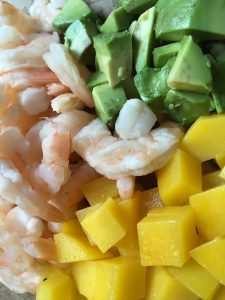
2-3 T cilantro, chopped
2-3 T lime juice
1 T vegetable oil
1 t. salt
1 t. black pepper
3-5 chopped green chilies (optional)
1/2 lb. cooked shrimp, shelled
1 avocado, peeled and cubed
1 mango, peeled and cubed
1 t. raw red chili pepper (optional)
1. Combine cilantro, lime juice, oil, salt, black pepper, and green chilies in a bowl, beating quickly to emulsify dressing.
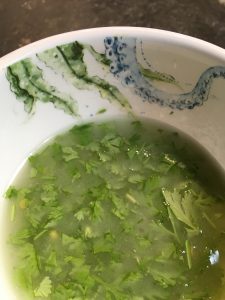
2. Stir in shrimp, avocado, and mango. Stir in red chili pepper if using. If you let it sit a little, maybe 15-20 minutes, it’ll blend better, but if you are impatient like me, you can just eat it straight up. Enjoy!
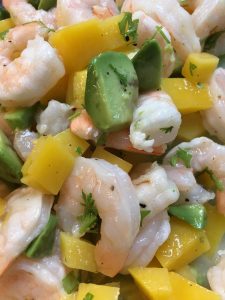
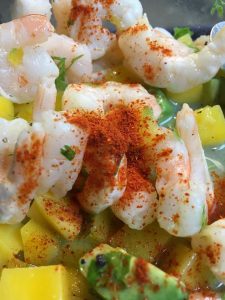
 One of my favorite summer treats is ripe mango, sliced and sprinkled with chili, salt, and lime. One of my favorite drinks is a mangaso margarita — made with mango puree, lime, and tequila, with a chili-salt rim. So those perfect summer flavors had to become a marshmallow. I only have a touch of salt in the recipe, but if you enjoy salt, do feel free to add a few flakes to the top of your marshmallow.
One of my favorite summer treats is ripe mango, sliced and sprinkled with chili, salt, and lime. One of my favorite drinks is a mangaso margarita — made with mango puree, lime, and tequila, with a chili-salt rim. So those perfect summer flavors had to become a marshmallow. I only have a touch of salt in the recipe, but if you enjoy salt, do feel free to add a few flakes to the top of your marshmallow.
1/2 c. mango puree
2 t. lime juice
1/4 t. salt
1/2 t. raw red chili powder or cayenne, plus more for sprinkling
3 packages unflavored gelatin
1 1/2 cups granulated sugar
1 cup light corn syrup
1/4 teaspoon salt
1/2 c. water
powdered (confectioner’s) sugar
butter (for greasing the pan)
14 oz. bittersweet chocolate chips
crushed red pepper for decorating
1. Combine mango puree with lime juice and chili powder in a small pot; bring to a boil, then turn down and simmer 3-5 minutes. This will help the mango to set.
2. Empty gelatin packets into bowl of stand mixer (whisk attachment), with mango-chili puree. Stir briefly to combine.
3. In a small saucepan (a bigger one will be heavy and hard to hold steadily at a later stage) combine water, granulated sugar, corn syrup, and salt. Cover and cook over medium high heat for 4 minutes. Uncover and cook until the mixture reaches soft ball stage (240 degrees if you have a candy thermometer), approximately 8 minutes. Once the mixture reaches this temperature, immediately remove from heat; if it continues, it will swiftly turn into hard candy.
4. Turn mixer on low speed and, while running, slowly pour the sugar syrup down the side of the bowl into the gelatin mixture. (Be very careful with the sugar syrup, as it is scaldingly hot and will burn you badly if it gets on your skin.) Once you’ve added all of the syrup, increase the speed to high.
5. Continue to whip until the mixture becomes very thick and is lukewarm, approximately 12 minutes.
6. While it’s whipping, butter a large 9 x 12 pan and dust with powdered sugar. Prepare an oiled spatula.
7. Pour the mixture into the prepared pan, spreading it evenly (and swiftly) with an oiled spatula.
8. Dust the top with enough of the remaining powdered sugar to lightly cover. Reserve the rest for later. Allow the marshmallows to sit uncovered for at least 4 hours and up to overnight.
9. Turn onto a board, cut into squares and dust all sides of each marshmallow with the remaining powdered sugar, using additional if necessary. May be stored in an airtight container for up to 3 weeks, or frozen.
10. If dipping, melt chocolate (either in microwave on 50% power, stirring every 30 seconds, or over double boiler), stir until smooth. Dip each marshmallow and let dry on waxed paper. Immediately sprinkle after dipping (you can dip the whole set first) with crushed red pepper.
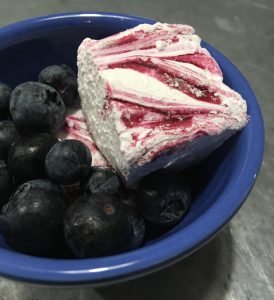 (45 minutes + cooling time, makes about 50)
(45 minutes + cooling time, makes about 50)
3 packages unflavored gelatin
1/2 cup water
1/2 c. soursop puree (from frozen is fine)
1 1/2 cups granulated sugar
1 cup light corn syrup
1/4 teaspoon salt
powdered (confectioner’s) sugar
butter (for greasing the pan)
blueberry simple syrup for marbling:
– 1 c. blueberries
– 1/2 c. granulated sugar
– 1/2 c. water
1. Empty gelatin packets into bowl of stand mixer (whisk attachment), with soursop puree. Stir briefly to combine.
2. In a small saucepan (a bigger one will be heavy and hard to hold steadily at a later stage) combine water, granulated sugar, corn syrup, and salt. Cover and cook over medium high heat for 4 minutes. Uncover and cook until the mixture reaches soft ball stage (240 degrees if you have a candy thermometer), approximately 8 minutes. Once the mixture reaches this temperature, immediately remove from heat; if it continues, it will swiftly turn into hard candy.
3. Turn mixer on low speed and, while running, slowly pour the sugar syrup down the side of the bowl into the gelatin mixture. (Be very careful with the sugar syrup, as it is scaldingly hot and will burn you badly if it gets on your skin.) Once you’ve added all of the syrup, increase the speed to high.
4. Continue to whip until the mixture becomes very thick and is lukewarm, approximately 12 minutes.
5. While it’s whipping, make simple syrup. Bring 1 c. blueberries, 1/2 c. granulated sugar, and 1/2 c. water to a boil. Boil for 10 minutes, stirring, then pour through a sieve. You’ll only need a few teaspoons of syrup; the rest of the berry mixture and syrup can be reserved for adding to yogurt, ice cream, spreading on toast, etc.

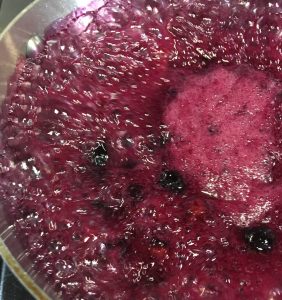
6. Butter a large 9 x 12 pan and dust with powdered sugar. Prepare an oiled spatula.
7. Pour the marshmallow mixture into the prepared pan, spreading it evenly (and swiftly) with an oiled spatula. Add a few drops of blueberry syrup scattered across the top and drag a knife through the marshmallow, lengthwise and crosswise, to create a marbled effect.

8. Dust the top with enough of the remaining powdered sugar to lightly cover. Reserve the rest for later. Allow the marshmallows to sit uncovered for at least 4 hours and up to overnight.
9. Turn onto a board, cut into squares and dust all sides of each marshmallow with the remaining powdered sugar, using additional if necessary. May be stored in an airtight container for up to 3 weeks, or frozen.

 When the kids have gone to bed, the grown-ups get their own marshmallows; tangy-sweet tamarind at the forefront with just a hint of chili at the end, dipped in luscious bittersweet chocolate.
When the kids have gone to bed, the grown-ups get their own marshmallows; tangy-sweet tamarind at the forefront with just a hint of chili at the end, dipped in luscious bittersweet chocolate.
1/2 c. tamarind puree
1/2 t. raw red chili powder or cayenne
3 packages unflavored gelatin
1 1/2 cups granulated sugar
1 cup light corn syrup
1/4 teaspoon salt
powdered (confectioner’s) sugar
butter (for greasing the pan)
14 oz. bittersweet chocolate chips
edible gold stars and crushed red pepper for decorating
1. Combine tamarind puree with chili powder. Empty gelatin packets into bowl of stand mixer (whisk attachment), with tamarind-chili puree. Stir briefly to combine.

2. In a small saucepan (a bigger one will be heavy and hard to hold steadily at a later stage) combine water, granulated sugar, corn syrup, and salt. Cover and cook over medium high heat for 4 minutes. Uncover and cook until the mixture reaches soft ball stage (240 degrees if you have a candy thermometer), approximately 8 minutes. Once the mixture reaches this temperature, immediately remove from heat; if it continues, it will swiftly turn into hard candy.
3. Turn mixer on low speed and, while running, slowly pour the sugar syrup down the side of the bowl into the gelatin mixture. (Be very careful with the sugar syrup, as it is scaldingly hot and will burn you badly if it gets on your skin.) Once you’ve added all of the syrup, increase the speed to high.
4. Continue to whip until the mixture becomes very thick and is lukewarm, approximately 12 minutes.
5. While it’s whipping, butter a large 9 x 12 pan and dust with powdered sugar. Prepare an oiled spatula.
6. Pour the mixture into the prepared pan, spreading it evenly (and swiftly) with an oiled spatula.
7. Dust the top with enough of the remaining powdered sugar to lightly cover. Reserve the rest for later. Allow the marshmallows to sit uncovered for at least 4 hours and up to overnight.
8. Turn onto a board, cut into squares and dust all sides of each marshmallow with the remaining powdered sugar, using additional if necessary. May be stored in an airtight container for up to 3 weeks, or frozen.
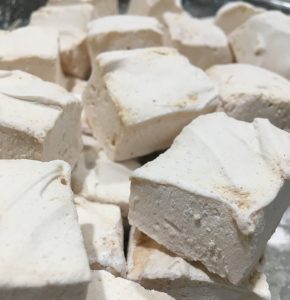
9. If dipping, melt chocolate (either in microwave on 50% power, stirring every 30 seconds, or over double boiler), stir until smooth. Dip each marshmallow and let dry on waxed paper. Immediately sprinkle after dipping (you can dip the whole set first) with crushed red pepper and edible gold stars.

 Fruity with just a hint of tang, these are the marshmallows of summer. They’re the ones I’d make for a child’s birthday party — Kavya loves them best of all the ones I’ve made so far. Sweet enough to please the kids, but light and fruity enough to delight adults as well.
Fruity with just a hint of tang, these are the marshmallows of summer. They’re the ones I’d make for a child’s birthday party — Kavya loves them best of all the ones I’ve made so far. Sweet enough to please the kids, but light and fruity enough to delight adults as well.
Soursop (also known as guanabana, custard apple, and Brazilian pawpaw) tastes something like a cross between strawberry and pineapple, with just a hint of banana. In northern America, your best chance at finding it is probably in Mexican grocers; look for frozen purees. Combine with fresh strawberries for a delicious treat!

3 packages unflavored gelatin
1/2 cup water
1/4 c. soursop puree (from frozen is fine)
1/4 c. strawberry puree
1 1/2 cups granulated sugar
1 cup light corn syrup
1/4 teaspoon salt
powdered (confectioner’s) sugar
butter (for greasing the pan)
red food coloring (optional)

1. Empty gelatin packets into bowl of stand mixer (whisk attachment), with soursop and strawberry purees. Stir briefly to combine.

2. In a small saucepan (a bigger one will be heavy and hard to hold steadily at a later stage) combine water, granulated sugar, corn syrup, and salt. Cover and cook over medium high heat for 4 minutes. Uncover and cook until the mixture reaches soft ball stage (240 degrees if you have a candy thermometer), approximately 8 minutes. Once the mixture reaches this temperature, immediately remove from heat; if it continues, it will swiftly turn into hard candy.
3. Turn mixer on low speed and, while running, slowly pour the sugar syrup down the side of the bowl into the gelatin mixture. (Be very careful with the sugar syrup, as it is scaldingly hot and will burn you badly if it gets on your skin.) Once you’ve added all of the syrup, increase the speed to high.
4. Continue to whip until the mixture becomes very thick and is lukewarm, approximately 12 minutes. Add food coloring, if using, during this stage.
5. While it’s whipping, butter a large 9 x 12 pan and dust with powdered sugar. Prepare an oiled spatula.
6. Pour the mixture into the prepared pan, spreading it evenly (and swiftly) with an oiled spatula.
7. Dust the top with enough of the remaining powdered sugar to lightly cover. Reserve the rest for later. Allow the marshmallows to sit uncovered for at least 4 hours and up to overnight.
8. Turn onto a board, cut into squares and dust all sides of each marshmallow with the remaining powdered sugar, using additional if necessary. May be stored in an airtight container for up to 3 weeks, or frozen.


 (45 minutes + cooling time, serves dozens)
(45 minutes + cooling time, serves dozens)
Inspired by a classic Sri Lankan cocktail made with ginger beer, lime, and arrack, a bourbon-like liquor derived from coconut flowers.
3 packages unflavored gelatin
1/4 c. ginger juice
1/4 c. lime juice
1/2 cup water
1 1/2 cups granulated sugar
1 cup light corn syrup
1/4 teaspoon salt
1/4 c. ginger beer
1/4 c. arrack
powdered (confectioner’s) sugar
butter (for greasing the pan)
green food coloring (optional)
1/2 c. culinary crystals (optional)
crystallized ginger, chopped fine (optional)
crystallized lime, cut into thin wedges (optional)
1. Empty gelatin packets into bowl of stand mixer (whisk attachment), with ginger juice and lime juice. Stir briefly to combine.
2. In a small saucepan (a bigger one will be heavy and hard to hold steadily at a later stage) combine water, granulated sugar, corn syrup, and salt. Cover and cook over medium high heat for 4 minutes. Uncover and cook until the mixture reaches soft ball stage (240 degrees if you have a candy thermometer), approximately 8 minutes. Watch carefully to ensure it doesn’t overheat.
3. Add ginger beer and arrack, which will reduce the temperature; continue simmering until it returns to soft ball stage / 240 degrees. Once the mixture reaches this temperature, immediately remove from heat; if it continues, it will swiftly turn into hard candy.
4. Turn mixer on low speed and, while running, slowly pour the sugar syrup down the side of the bowl into the gelatin mixture. (Be very careful with the sugar syrup, as it is scaldingly hot and will burn you badly if it gets on your skin.) Once you’ve added all of the syrup, increase the speed to high.
5. Continue to whip until the mixture becomes very thick and is lukewarm, approximately 12 minutes. Add food coloring, if using, during this stage.
6. While it’s whipping, butter a large 9 x 12 pan and dust with powdered sugar. Prepare an oiled spatula.
7. Turn mixer to low and add culinary crystals, stirring for a few moments to blend. Pour the mixture into the prepared pan, spreading it evenly (and swiftly) with an oiled spatula.
8. Top with crystallized ginger and lime if desired, pressing in slightly. Dust the top with enough of the remaining powdered sugar to lightly cover. Reserve the rest for later. Allow the marshmallows to sit uncovered for at least 4 hours and up to overnight.
9. Turn onto a board, cut into squares and dust all sides of each marshmallow with the remaining powdered sugar, using additional if necessary. May be stored in an airtight container for up to 3 weeks, or frozen.
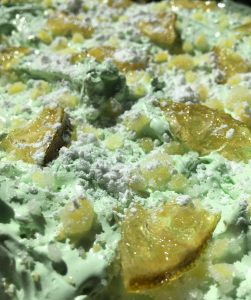
 (45 minutes + cooling time, serves dozens)
(45 minutes + cooling time, serves dozens)
You can freeze ginger, grate it with a microplane grater, and then squeeze juice out of the grated ginger, but that’s pretty labor intensive for this much juice. I used Ginger People’s ginger juice, available online.
3 packages unflavored gelatin
1/4 c. ginger juice
1/4 c. lime juice
1 1/2 cups granulated sugar
1 cup light corn syrup
1/2 cup water
1/4 teaspoon salt
powdered (confectioner’s) sugar
butter (for greasing the pan)
green food coloring (optional)
crystallized ginger, chopped fine (optional)
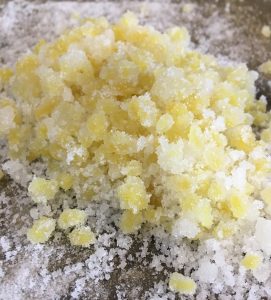
1. Empty gelatin packets into bowl of stand mixer (whisk attachment), with ginger juice and lime juice. Stir briefly to combine.
2. In a small saucepan (a bigger one will be heavy and hard to hold steadily at a later stage) combine water, granulated sugar, corn syrup, and salt. Cover and cook over medium high heat for 4 minutes. Uncover and cook until the mixture reaches soft ball stage (240 degrees if you have a candy thermometer), approximately 8 minutes. Once the mixture reaches this temperature, immediately remove from heat; if it continues, it will swiftly turn into hard candy.
3. Turn mixer on low speed and, while running, slowly pour the sugar syrup down the side of the bowl into the gelatin mixture. (Be very careful with the sugar syrup, as it is scaldingly hot and will burn you badly if it gets on your skin.) Once you’ve added all of the syrup, increase the speed to high.
4. Continue to whip until the mixture becomes very thick and is lukewarm, approximately 12 minutes. Add food coloring, if using, during this stage.
5. While it’s whipping, butter a large 9 x 12 pan and dust with powdered sugar. Prepare an oiled spatula.
6. Pour the mixture into the prepared pan, spreading it evenly (and swiftly) with an oiled spatula.
7. Sprinkle chopped crystallized ginger on top, pressing in slightly. Dust the top with enough of the remaining powdered sugar to lightly cover. Reserve the rest for later. Allow the marshmallows to sit uncovered for at least 4 hours and up to overnight.
8. Turn onto a board, cut into squares, and dust all sides of each marshmallow with the remaining powdered sugar, using additional if necessary. May be stored in an airtight container for up to 3 weeks, or frozen.
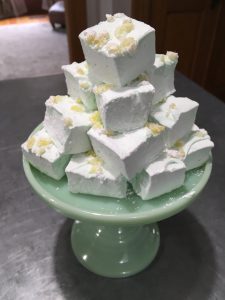
 (45 minutes + cooling time, serves dozens)
(45 minutes + cooling time, serves dozens)
Love the tang of the blood orange here, cutting the fruity sweetness of the passionfruit marshmallows
3 packages unflavored gelatin
1/2 cup water
1/4 c. passionfruit puree (from frozen is fine)
1/4 c. blood orange juice (about one orange)
1 1/2 cups granulated sugar
1 cup light corn syrup
1/4 teaspoon salt
powdered (confectioner’s) sugar
butter (for greasing the pan)
yellow or orange food coloring (optional)
red food coloring for marbling (optional)
1. Empty gelatin packets into bowl of stand mixer (whisk attachment), with passionfruit puree and blood orange juice. Stir briefly to combine.


2. In a small saucepan (a bigger one will be heavy and hard to hold steadily at a later stage) combine water, granulated sugar, corn syrup, and salt. Cover and cook over medium high heat for 4 minutes. Uncover and cook until the mixture reaches soft ball stage (240 degrees if you have a candy thermometer), approximately 8 minutes. Once the mixture reaches this temperature, immediately remove from heat; if it continues, it will swiftly turn into hard candy.
3. Turn mixer on low speed and, while running, slowly pour the sugar syrup down the side of the bowl into the gelatin mixture. (Be very careful with the sugar syrup, as it is scaldingly hot and will burn you badly if it gets on your skin.) Once you’ve added all of the syrup, increase the speed to high.
4. Continue to whip until the mixture becomes very thick and is lukewarm, approximately 12 minutes. Add food coloring, if using for the whole batch, during this stage.
5. While it’s whipping, butter a large 9 x 12 pan and dust with powdered sugar. Prepare an oiled spatula for later.
6. Pour the mixture into the prepared pan, spreading it evenly (and swiftly) with an oiled spatula. (You can add a few drops of red food coloring and drag a knife through them, to create a marbled effect.)
7. Dust the top with enough of the remaining powdered sugar to lightly cover. Reserve the rest for later. Allow the marshmallows to sit uncovered for at least 4 hours and up to overnight.
8. Turn onto a board, cut into squares and dust all sides of each marshmallow with the remaining powdered sugar, using additional if necessary. May be stored in an airtight container for up to 3 weeks, or frozen.
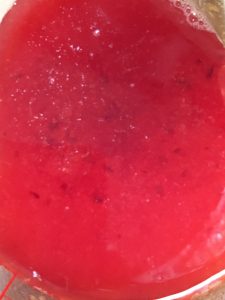

 (45 minutes + cooling time + 30 minutes for dipping, serves dozens)
(45 minutes + cooling time + 30 minutes for dipping, serves dozens)
I’d start these the day before you want them finished, because you need to let them cool for quite a while before cutting and dipping (and then they’ll need maybe 30 more minutes before serving). But not too much in advance, because homemade marshmallows maintain texture best when fresh (though they can keep for about three weeks in a sealed container, or can even be frozen). Plan appropriately!
3 packages unflavored gelatin
1/2 cup water
1/2 c. passionfruit puree (from frozen is fine)
1 1/2 cups granulated sugar
1 cup light corn syrup
1/4 teaspoon salt
powdered (confectioner’s) sugar
butter (for greasing the pan)
yellow or orange food coloring (optional)
10 oz. bittersweet chocolate, chopped or chips
1. Empty gelatin packets into bowl of stand mixer (whisk attachment), with passionfruit puree. Stir briefly to combine.
2. In a small saucepan (a bigger one will be heavy and hard to hold steadily at a later stage) combine water, granulated sugar, corn syrup, and salt. Cover and cook over medium high heat for 4 minutes. Uncover and cook until the mixture reaches soft ball stage (240 degrees if you have a candy thermometer), approximately 8 minutes. Once the mixture reaches this temperature, immediately remove from heat; if it continues, it will swiftly turn into hard candy.
3. Turn mixer on low speed and, while running, slowly pour the sugar syrup down the side of the bowl into the gelatin mixture. (Be very careful with the sugar syrup, as it is scaldingly hot and will burn you badly if it gets on your skin.) Once you’ve added all of the syrup, increase the speed to high.
4. Continue to whip until the mixture becomes very thick and is lukewarm, approximately 12 minutes. Add food coloring, if using for the whole batch, during this stage.
5. While it’s whipping, butter a large 9 x 12 pan and dust with powdered sugar. Prepare an oiled spatula for later.
6. Pour the mixture into the prepared pan, spreading it evenly (and swiftly) with an oiled spatula.
7. Dust the top with enough of the remaining powdered sugar to lightly cover. Reserve the rest for later. Allow the marshmallows to sit uncovered for at least 4 hours and up to overnight.
8. Turn the marshmallows out onto a cutting board and cut into squares. As you’re cutting, lightly dust all sides of each marshmallow with the remaining powdered sugar, using additional if necessary. May be stored in an airtight container for up to 3 weeks, or frozen. They’re delicious straight up at this point, if you don’t want to dip them.
9. Dip in melted chocolate chips (melt in microwave on 50% power for a few minutes, in 30 second bursts, stirring in between); add sprinkles if desired, then lay on wax paper to dry for about 30 minutes.
